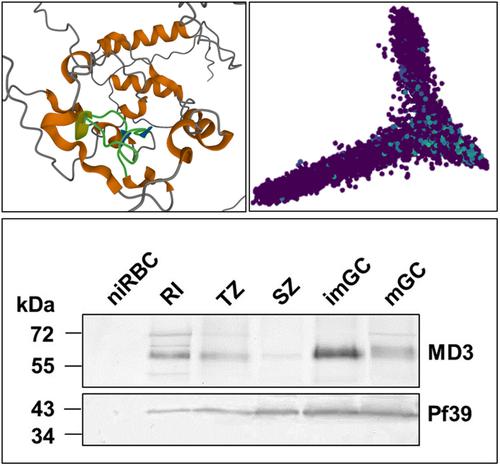当前位置:
X-MOL 学术
›
Mol. Microbiol.
›
论文详情
Our official English website, www.x-mol.net, welcomes your feedback! (Note: you will need to create a separate account there.)
The Plasmodium falciparum CCCH zinc finger protein MD3 regulates male gametocytogenesis through its interaction with RNA-binding proteins
Molecular Microbiology ( IF 3.6 ) Pub Date : 2023-12-26 , DOI: 10.1111/mmi.15215 Afia Farrukh 1 , Jean Pierre Musabyimana 1 , Ute Distler 2 , Vanessa Jil Mahlich 1 , Julius Mueller 1 , Fabian Bick 1 , Stefan Tenzer 2 , Gabriele Pradel 1 , Che Julius Ngwa 1
Molecular Microbiology ( IF 3.6 ) Pub Date : 2023-12-26 , DOI: 10.1111/mmi.15215 Afia Farrukh 1 , Jean Pierre Musabyimana 1 , Ute Distler 2 , Vanessa Jil Mahlich 1 , Julius Mueller 1 , Fabian Bick 1 , Stefan Tenzer 2 , Gabriele Pradel 1 , Che Julius Ngwa 1
Affiliation

|
The transmission of malaria parasites to mosquitoes is dependent on the formation of gametocytes. Once fully matured, gametocytes are able to transform into gametes in the mosquito's midgut, a process accompanied with their egress from the enveloping erythrocyte. Gametocyte maturation and gametogenesis require a well-coordinated gene expression program that involves a wide spectrum of regulatory proteins, ranging from histone modifiers to transcription factors to RNA-binding proteins. Here, we investigated the role of the CCCH zinc finger protein MD3 in Plasmodium falciparum gametocytogenesis. MD3 was originally identified as an epigenetically regulated protein of immature gametocytes and recently shown to be involved in male development in a barcode-based screen in P. berghei. We report that MD3 is mainly present in the cytoplasm of immature male P. falciparum gametocytes. Parasites deficient of MD3 are impaired in gametocyte maturation and male gametocytogenesis. BioID analysis in combination with co-immunoprecipitation assays unveiled an interaction network of MD3 with RNA-binding proteins like PABP1 and ALBA3, with translational initiators, regulators and repressors like elF4G, PUF1, NOT1 and CITH, and with further regulators of gametocytogenesis, including ZNF4, MD1 and GD1. We conclude that MD3 is part of a regulator complex crucial for post-transcriptional fine-tuning of male gametocytogenesis.
中文翻译:

恶性疟原虫 CCCH 锌指蛋白 MD3 通过与 RNA 结合蛋白相互作用调节雄性配子细胞发生
疟疾寄生虫向蚊子的传播取决于配子体的形成。一旦完全成熟,配子体就能在蚊子的中肠中转化为配子,这一过程伴随着配子体从包膜红细胞中排出。配子体成熟和配子发生需要良好协调的基因表达程序,涉及广泛的调节蛋白,从组蛋白修饰剂到转录因子再到 RNA 结合蛋白。在这里,我们研究了 CCCH 锌指蛋白 MD3 在恶性疟原虫配子细胞发生中的作用。MD3 最初被鉴定为未成熟配子细胞的表观遗传调节蛋白,最近通过基于条形码的伯氏疟原虫筛选显示其参与雄性发育。我们报道MD3主要存在于未成熟雄性恶性疟原虫配子细胞的细胞质中。缺乏 MD3 的寄生虫配子细胞成熟和雄性配子细胞发生受到损害。BioID 分析与免疫共沉淀分析相结合,揭示了 MD3 与 PABP1 和 ALBA3 等 RNA 结合蛋白的相互作用网络,以及 eF4G、PUF1、NOT1 和 CITH 等翻译启动子、调节子和抑制子,以及配子细胞发生的进一步调节子,包括 ZNF4 、MD1 和 GD1。我们得出的结论是,MD3 是对雄性配子细胞发生的转录后微调至关重要的调节复合物的一部分。
更新日期:2023-12-26
中文翻译:

恶性疟原虫 CCCH 锌指蛋白 MD3 通过与 RNA 结合蛋白相互作用调节雄性配子细胞发生
疟疾寄生虫向蚊子的传播取决于配子体的形成。一旦完全成熟,配子体就能在蚊子的中肠中转化为配子,这一过程伴随着配子体从包膜红细胞中排出。配子体成熟和配子发生需要良好协调的基因表达程序,涉及广泛的调节蛋白,从组蛋白修饰剂到转录因子再到 RNA 结合蛋白。在这里,我们研究了 CCCH 锌指蛋白 MD3 在恶性疟原虫配子细胞发生中的作用。MD3 最初被鉴定为未成熟配子细胞的表观遗传调节蛋白,最近通过基于条形码的伯氏疟原虫筛选显示其参与雄性发育。我们报道MD3主要存在于未成熟雄性恶性疟原虫配子细胞的细胞质中。缺乏 MD3 的寄生虫配子细胞成熟和雄性配子细胞发生受到损害。BioID 分析与免疫共沉淀分析相结合,揭示了 MD3 与 PABP1 和 ALBA3 等 RNA 结合蛋白的相互作用网络,以及 eF4G、PUF1、NOT1 和 CITH 等翻译启动子、调节子和抑制子,以及配子细胞发生的进一步调节子,包括 ZNF4 、MD1 和 GD1。我们得出的结论是,MD3 是对雄性配子细胞发生的转录后微调至关重要的调节复合物的一部分。



























 京公网安备 11010802027423号
京公网安备 11010802027423号